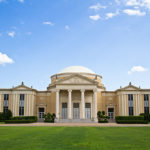BELTON—David Hill was sitting in a worship service one day when he realized he needed to use his God-given artistic talents to serve his church.
Hill, an associate professor of art at the University of Mary Hardin-Baylor, began sketching his idea. He wanted to give Vista Community Church, a Texas Baptist congregation in Temple, a work of art that could engage and even enrich faith. He envisioned a creation that would be both a learning tool and an expression of faith. So, the Bible Project was born.

When completed, the Bible Project will be made up of 66 individual ceramic tiles, each with low-relief sculptural elements that correspond with a book of the Bible. Hill’s tiles are designed to be installed together on a wall to form one unified work of art.
Each tile has a stylized cross, and when all 66 pieces are arranged together, a larger cross is formed by the orientation of the smaller crosses.
“The big idea behind this is that each book individually tells part of the story of Jesus and the gospel. The full image of the cross can only be appreciated when viewing the totality of Scripture,” Hill said.
Instead of using words, Hill’s goal is to communicate with images and symbols to tell the story of the Bible. However, he doesn’t simply want to illustrate the stories.
Christ in every book of the Bible
“There is plenty of Bible illustration out there,” he said. “I would rather allow images and symbols to speak to the deeper themes of who Jesus is within each book.”
He wants to show others how Christ is revealed in each book of the Bible—from Creator in Genesis to Alpha and Omega in Revelation.
For instance, on the tile representing the book of Ruth, Hill wanted to show how God is seen as provider and kinsman redeemer. So, he molded and painted ears of barley growing in the sun.
Sign up for our weekly edition and get all our headlines in your inbox on Thursdays
Hill started work on the Bible Project in 2014, but he’s only been able to work part-time because it is such a massive undertaking, and he has had to prioritize his job as an educator and practicing artist with an active exhibition record.
The process of researching and creating the 66 tiles has been long but worth it, because he has “learned more about who God is, as revealed in his word,” he said.
Hill grew up as a self-described “missionary kid” in the mission field with parents who served with the Southern Baptist Convention’s International Mission Board in Manila, Philippines. Even though he says he spent his entire life going to church and reading the Bible, Hill said, the Bible Project has allowed him to discover things in Scripture he didn’t know.
“Finding the connections between the different books and how the history moves through the books—you don’t necessarily learn about the Bible that way in Sunday school and church,” he said.
Learning and teaching
“I enjoyed learning about the interesting connections between the books and the historical details of the biblical figures. This project has fed my desire to continue reading and stay in the Bible.”

Hill said “The Bible Project” is only a working title, since he typically doesn’t title an artwork until it is finished. His dedication to meticulous research is evident when an observer looks closely at the intricate detailing of his work.
“My ideas for imagery came quickly for some of the books, but other books have been much harder and have taken a lot of reading through the Bible, as well as various Biblical commentaries and art history books,” he said.
“Early on, I set some challenges and limitations for myself to direct my research. I wanted to communicate primarily with images and visual symbols rather than words, because I firmly believe that images speak to people in unique and often powerful ways, even if that is simply seen in communicating across language barriers.”
As a professor, he often uses his artwork and creative practice as a teaching tool.
“This project, in particular, has allowed me to provide students with an example of how art can engage issues of faith as well as serve the church and the community at large,” he said.
In addition to the tiles, Hill also loves making bowls, mugs and other functional vessels.
Even when his art is not always explicitly about the Bible or Christian themes, Hill’s faith has been an integral part of how he sees the world and what he values. So, in a sense, his artwork always is influenced by his faith, he said.
“I find value in hand-made items that are used daily for sustenance as well as to build community,” Hill said. “So, whether I am creating a Bible-inspired sculpture or a simple mug for daily use, I believe I am living out God’s call in my life as an image-bearer of my Creator.”














We seek to connect God’s story and God’s people around the world. To learn more about God’s story, click here.
Send comments and feedback to Eric Black, our editor. For comments to be published, please specify “letter to the editor.” Maximum length for publication is 300 words.